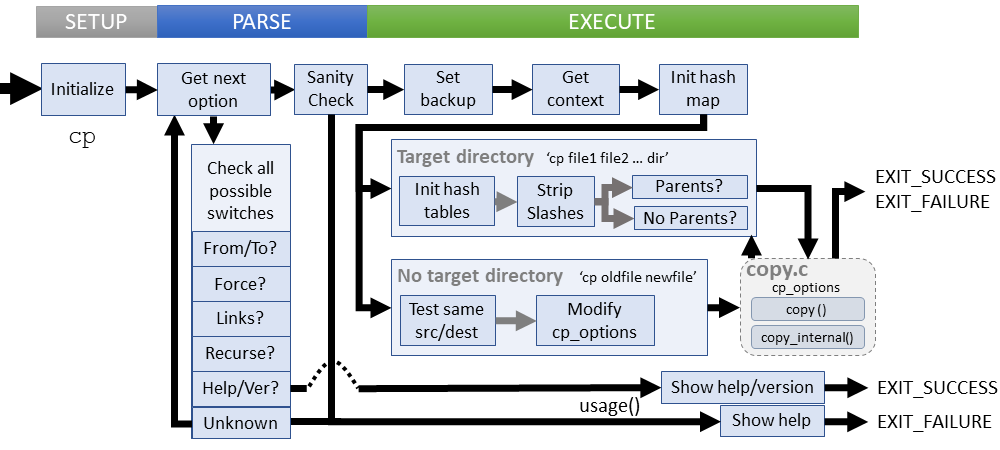[GNU Manual] [POSIX requirement] [Linux man] [FreeBSD man]

Summary
cp - copy files and directories
Lines of code: 1227
Principal syscall: None
Support syscalls: stat(), open(), close()
Options: 50 (21 short, 29 long)
Descended from cp introduced in Version 1 UNIX (1971)
Added to Fileutils in October 1992 [First version]
Number of revisions: 327
Much of the work behind the cp utility passes through support functions in copy.c which are shared among the mv, and install utilities
cp_option_init()- Initializes thecp_optionsstructuredecode_preserve_arg()- Processes argument provded by the user with --preservedo_copy()- The top-level copy procedure for all the requested targetsmake_dir_parents_private()- Verifies that the parent directory existsre_protect()- Verifies parent directory access propertiestarget_directory_operand()- Verifies that the target is a directory
copy()- The copy interface forcopy.cto perform the task using provided optionsdie()- Exit with mandatory non-zero error and message to stderrerror()- Outputs error message to standard error with possible process termination
Setup
cp uses several global flags and variables, including:
parents_option- Flag to use an existing directory for each given file (--parents)remove_trailing_slashes- Flag to remove trailing slashes from sourcesselinux_enabled- Flag set if SELinux services are enabled on the system
main() adds a few locals before starting parsing:
backup_suffix- The user-provided backup file suffix (-S)c- The next option character to processcopy_contents- Flag to force copy of special file contents (--copy-contents)make_backups- Flag to make backups of files that change (-b)no_target_directory- Treat the final operand as a file (-T)ok- The final return status*scontext- The security context*target_directory- The user-provided target directory (-t)*version_control_string- The user-provided backup method (-b)x- The copy options (as astruct cp_options)
Parsing
Parsing breaks down the user-provided options to answer these questions about the copy procedure:
- Which files do we copy and where to?
- Should we create a backup, if so, is there a special suffix?
- Should the operation force move?
- Any special treatment for links or other special files?
- Is this is a recursive operation?
- Is there a security context?
Parsing failures
These failure cases are explicitly checked:
- Trying to create a hard and a soft link
- Using --no-clobber and --backup at the same time
- Using --reflink without --sparse=auto
- Try to set and preserve the security context
- Specifying a security context without SELinux
- Unknown option used
User specified parsing failures result in a short error message followed by the usage instructions. Access related parsing errors die with an error message.
Execution
The key organization idea behind cp is that the source/dest files/directories are shuffled to the copy() interface along with control information within the cp_options structure
The execution path splits along the two possible cp forms: copying src to dest and copying files to a target directory. The processes look like this:
The overall process for cp looks like this:
- Gather the backup type and set the naming convention
- Set up the security context as requested
- Initialize a hash table for file name search (see cp-hash.c)
- Copy oldfile to newfile:
- Test for edge case when force and backup is used on the same source and destination
- Pass names and options to
copy()
- Copy file(s) to destination directory:
- Initialize hash lookup tables for source and destination (fast problem detection)
- Remove the trailing slashes from the source files
- Apply the parent directory name or else...
- Update the current directory name
- Pass the source/destination arguments and copy options to copy()
- Repeat the copy for the next source file provided (for the target directory case)
- Return the exit status from
copy()
Failure cases:
- Too many repeating lines
- Unable to open or close I/O files
- Unable to read from input source
All failures at this stage output an error message to STDERR and return without displaying usage help